If you have not lost a television, radio, VCR or some other electronic piece of equipment in your home or at your place of business because of a surge, I would have to say you are a rare find. When a surge occurs in a power distribution system, Murphy’s Law states: the most expensive piece of equipment connected to the power system will sacrifice itself for the sake of those less costly to replace. It occurs all too often. The proper selection, placement, and installation of surge mitigating products can help reduce the cost of lost equipment. So let’s explore this thing called surge.
What is a surge?
Yes, we call them surge devices and we will say they protect from surges, but the generic word “surge” is not helpful when trying to understand what is occuring in the power distribution system that causes damage and demands the installation of mitigation equipment. What we are talking about is a transient event; a transient voltage event that lasts for a very short duration and that can be devastating immediately or over time to the equipment subjected to its magnitude and repetitiveness.
Transient events are, in fact, not new occurrences in our power distribution systems. I could argue that it was not until the growth of the semi-conductor industry that the damaging potential of these events were revealed on a widespread basis. As sensitive electronic equipment infiltrated the power distribution system, one that operated for years with no issues, the prevalence of equipment failures make it appear that the power system has changed. I could liken this to a polluted body of water that appears tranquil and harmless until someone decides to stock it with trout. The fact that the new inhabitants begin to die is not a sign that the body of water has all of a sudden become polluted, it merely means that the polluted water has finally met an inhabitant that cannot withstand what it has to offer. Simply look through your home and count the number of items that now have electronic components within and think about how recently that equipment has changed to include sensitive electronic components.
I don’t know about you but in my day a refrigerator was just an appliance that kept things cold, or frozen, or both, and all you had to do is plug it in. Today, refrigerators are being equipped with electronics from the basic temperature control to the extent of having a television screen or equivalent on the door that includes the ability to accesses the web. When I was growing up, the most sophisticated thing on our family stove / oven was the analog clock that included a timer. Contrast that to today’s stove that can be controlled directly from your smart phone. Our stoves, dishwashers, clothes washers, dryers and more are all being equipped with this type of technology that is sensitive to transient voltage events. The growth of sensitive electronic equipment in the power system of today and tomorrow has and will continue to remind us of the importance of good power quality.
A transient voltage event in a power distribution system impacts a wide audience of circuits. In general, changes in voltage on a bus impact all of the connected circuits to that bus. This is why transient voltage events are of such concern and can impact a wide array of loads in the system.
Transient events can be placed into two categories: impulse and oscillatory transients.
Impulse Transients: An impulse transient has a fast rise time and a rapid decay. It packs a lot of energy into that short time period that it exists. Sometimes we will refer to these types of events as “voltage spikes.” These transient events can last from 0.5 to 200 microseconds. Typical causes of these types of events include lightning, electrostatic discharge, load switching, and capacitor switching. These events have been known to destroy equipment such as computers, televisions and more.
Oscillatory Transients: An oscillatory transient also has a fast rise time but includes oscillations that ride the sine wave and decay relatively quickly. These events may pack a lower amount of energy than impulse transients pack but remain on the system longer. They can last up to 1 cycle. Typical causes of these types of events include line/cable switching, capacitor switching, load switching. These events can have long-term impacts on electrical equipment and may not result in immediate damage to equipment.
Lightning peak voltages can be as high as 20,000 volts on average and occur as often as weekly to very rarely depending upon geography. Lightning strikes may be very rare in Oregon but common occurrences in Florida. The following URL from the National Weather Association is a great resource to learn more about lightning events abroad — http://www.nwas.org/committees/rs/ltng.html Some may feel that all they have to worry about is lightning, when in reality there are other sources of dangerous transient events that are not tied to geography or weather conditions that occur more frequently.
Utility system switching, including capacitor switching, can realize surge peaks as high as 1,300 volts on a 480 V system and are oscillatory by nature. These surge magnitudes may indeed be much less than what you would see from a lightning strike but may occur more often causing damage over time due to repetition. The frequency of switching events will vary from utility to utility and residential homes are not immune to these events.
Switching internal to a facility or a home is also a source of transient voltage events. Events as common and as simple as switching lighting loads can cause a significant surge in the system. An industrial or commercial facility can experience transient voltages as high as 2,000 volts on a 480 V system. These events can occur many times a day as frequency of internal switching will depend upon processes and operation of the equipment within the system. These frequent and persistent events can have severe effects on equipment over time. It is like a small drop of water on a bar of soap. One or two drops are not noticeable but a bar of soap subjected to small drops of water consistently over time will erode and deform the soap. Electronic equipment subjected to persistent surges over time erodes as well, and eventually shows the results of this wear.
The fact is that transients will vary in both current and voltage wave shapes and in magnitudes as every power distribution system and disturbance is different. The primary cause of these events is either lightning or switching. As noted above, switching events can be on the utility or facility side of the system. Lightning events produce powerful short duration events and do not have to be a direct hit experience to the electrical system. A lightning event that misses overhead utility lines, striking a nearby tree or other object can induce high voltages onto the nearby overhead distribution system. Either way, a lightning event could arguably be considered the event that causes the largest transients that pack the most energy a power distribution system experiences.
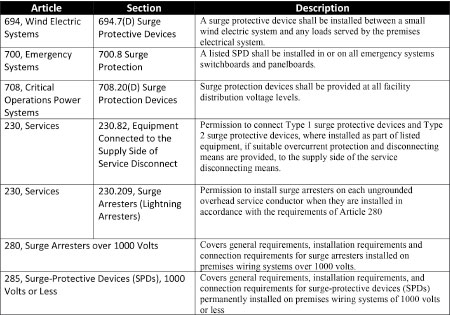
Surge Impact
Transient voltages impact the power distribution system in various ways, ultimately depending upon the magnitude of the surge and the type of equipment experiencing the event. The impact can be as subtle as a reboot of microprocessor driven equipment and/or data loss, to as severe as a violent destruction of installed equipment resulting in fire. The fact is that it does not take a lightning strike to inflict damage. Smaller magnitude transients, those not even exceeding the peak voltage of the ac power systems nominal voltage, can have a negative impact on connected loads. These very small voltage surges at the power input terminals of sensitive electronic equipment have been documented to cause disruption of data flow and integrity. Rest assured that at some point the amplitude and related energy of the transient event will cause damage to electronic equipment.
From a safety perspective, surge events have been noted to impact safety related equipment. A recent report generated by the Fire Protection Research Foundation, “Data Assessment for Electrical Surge Protection Devices,” revealed some information and statistics that should cause anyone to raise an eyebrow. One interesting fact is that surges have damaged safety related appliances and products including smoke detectors, CO2 detectors, fire alarm systems, security systems, GFCIs, emergency lighting, emergency generators, fire pumps, elevators and escalators and more. This report revealed that 48% of the respondents to a questionnaire indicated that their facility had experienced unexplained process interruptions. More than a third of the respondents reported occurrences of locked up computers or industrial process systems as well. Damage to safety related equipment is a possibility and interruption to processes may indirectly lead to safety concerns as well. This should not be a new revelation to our industry as many books and other publications document equipment damage due to surge events. I know I have personally lost a television, VCR (now I’m showing my age again), and other electronic equipment in my home and I’m sure I’m not alone.
Surge was also recognized as a concern during the recent NEC 2014 code cycle. During this cycle, a new Section 700.8 was added mandating a listed surge protection device to be installed in or on all emergency system switchboards and panelboards. Requirements for surge go back in time with regard to the NEC as requirements are also a part of Article 708 for critical operations power systems; Section 708.20(D) requires surge protective devices at all facility distribution voltage levels. Health care facilities too are now requiring surge through the reference section 517.26 that pulls in the requirements of Article 700 for the life safety branch of the essential electrical system thus realizing the requirement of Section 700.8 as noted above.
Indeed, other sections in the NEC mandate the installation of surge, permit the installation of surge or have installation requirements when surge is installed. The following list is a highlight of applicable areas in NEC 2014 pertaining to surge product installations.
Surge devices can help protect safety related equipment and can help ensure proper operation of the power distribution system and its components.
Types of Surge Products
So, I’m sure if you decided to go out and specify or acquire a surge device for your facility, you found out that it’s not a “one shoe fits all” type of thing. Life just “ain’t that simple.” We can reference a few good resources to help us understand what a surge device is and what the types are, but I always like to start with NEC Article 100. Sometimes, I need not look any further. NEC 2014 Article 100 defines a surge-protective device (SPD) as “A protective device for limiting transient voltages by diverting or limiting surge current; it also prevents continued flow of follow current while remaining capable of repeating these functions… .” The definition includes the following four types of SPD:
“Type 1: Permanently connected SPDs intended for installation between the secondary of the service transformer and the line side of the service disconnect overcurrent device.
“Type 2: Permanently connected SPDs intended for installation on the load side of the service disconnect overcurrent device, including SPDs located at the branch panel.
“Type 3: Point of utilization SPDs.
“Type 4: Component SPDs, including discrete components, as well as assemblies.”
In addition to the above, the definition has an Informational Note to offer further information on these type designations sending us to UL 1449, Standard for Surge Protective Devices. A more attractive option than purchasing the UL standard as a resource of information is the UL White Book (www.ul.com/whitebook) which takes the information that you need to know to properly apply a product and provides it in a means that makes sense. You can start your journey in this reference with Category Code “VZCA” for surge-protective devices. Your journey in the White Book can take you to category codes VZQK for “Surge Arresters over 1000 Volts” and VZQO for “Sure Protectors and Isolators for use on Cathodically Protected Systems for use in hazardous locations.” This reference is a great resource for our industry and I highly recommend reviewing it if you have not done so already. Here is just a taste of some of the sections in the White Book that pertain to surge products:
- Circuit Breakers and Surge-protective Devices (DIMV)
- Surge-protective Devices Classified for Use in Specified Equipment (OWIW)
- Surge-protective Devices (VZCA)
- Surge Arresters Over 1000 Volts (VZQK)
- Surge Protectors and Isolators for Use on Cathodically Protected Systems for Use in Hazardous Locations (VZQO)
- Surge-protective Device/Panelboard Extension Modules Classified for Use with Specified Equipment (XUPD)
Figure 2 is an illustration that may provide some help in understanding the locations of surge products, what can be placed where. It is important to understand that care must be taken when applying the DIN Rail mounted surge devices shown as these devices are meant for equipment / machine builders or panelboard builders to be placed in equipment to provide surge protection and cannot be simply used throughout the system. Always follow manufacturer’s instructions and read / understand the product labels.
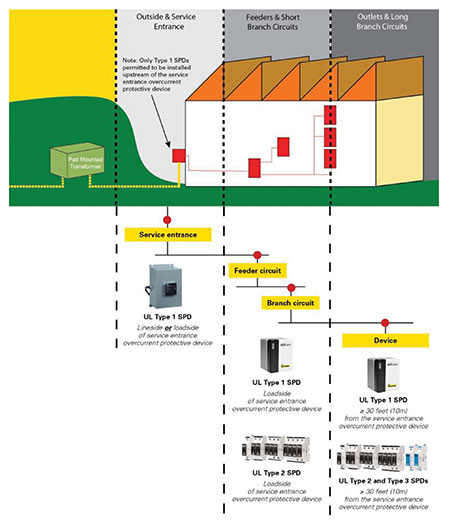
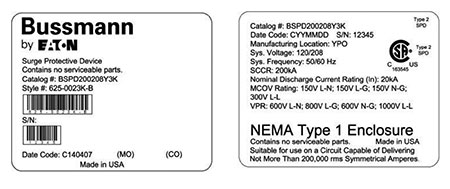
When it comes to the label of a surge device, there is a lot of information important to its proper application. Let’s review a sample label as shown in figure 3. This label has the following important information:
Manufacturer information: For this product, it is Bussmann by Eaton.
- Date Code: For this product, it is C140407. Each manufacturer may have a different way of displaying a date code that may not be as simple as a month, day and year. You may be presented with a code that the manufacturer can help decipher.
- Voltage Protection Rating (VPR): This rating is selected from a list of preferred values as part of UL 1449 Table 63.1. The value of VPR is determined as the nearest highest value taken from said table to the measured limiting voltage combination wave generator at a setting of 6kV and 3kA. For this product, the label indicates its VPR is 600V L-N; 800V L-G; and 1000V L-L.
- Electrical Ratings including operating voltage, ac power frequency, and number of phases, or simply dc if rated for dc. The load current should be included as well. For this product, the electrical ratings are as follows:
System Voltage: 120/208
System Frequency: 50/60 Hz
- Nominal Discharge Current (In) Rating. For this product, it is 20kA.
- Maximum Continuous Operating Voltage Rating (MCOV). For this product 150V L-N, 150V L-G, 150V N-G, 300V L-L
- Short-Circuit Current Rating (SCCR). For this product, it is 200kA.
Pay close attention to labeling and installation instructions as important details cannot only help ensure proper operation but also ensure you do not violate NEC requirements. For example, the instructions will indicate details about how long of a lead length you should try to maintain and what the impact is, as the longer the lead length the less effective the product is in mitigating surge events. You may have met a code requirement by placing a surge device into the system as required by the NEC but with a long lead length, you may have paid for a product without obtaining any of the performance benefits because of the lead length used in the installation. In addition, for photovoltaic systems, SPDs must be marked “For Use in Photovoltaic Systems Only” or equivalent.
Surge protective devices are either connected in parallel or connected in series with the equipment for which protection is desired. It operates to address the voltage increase during a surge event by shunting the extra energy to ground when the transient voltage exceeds a specific threshold. These devices are quite effective when applied correctly as specified by the manufacturer. One aspect of surge that many individuals forget is the inclusion of surge protection for data and signaling in addition to power lines. Surges can come into a facility through more ways than just through the power lines.
Resources
The following resources can help expand your knowledge of surge and their proper application.
NEMA Surge Protection Institute: http://www.nemasurge.org/reference-materials/
Fire protection research foundation Surge Report “Data Assessment for Electrical Surge Protection Devices”: http://www.nfpa.org/~/media/Files/Research/Research%20Foundation/Research%20Foundation%20reports/Electrical/RFDataAssessmentforElectricalSurgeProtectionDevices.pdf
Fire protection research foundation: http://www.nfpa.org/research/fire-protection-research-foundation
Surge protection application guide: http://www.cooperindustries.com/content/dam/public/bussmann/Electrical/Resources/technical-literature/bus-ele-an-3193-ul-spd-guide.pdf
Closing Remarks
The need for surge suppression in general is driven by the increased use of sensitive electronic equipment that can be impaired or destroyed by surges on power circuits or through the coaxial cable, twisted pair or Ethernet cables that connect them. The National Electrical Code and practical experience tell us that leveraging all forms of SPDs available, data signal SPDs in addition to power SPDs, helps protect data and sensitive electrical equipment that just may include safety related devices.

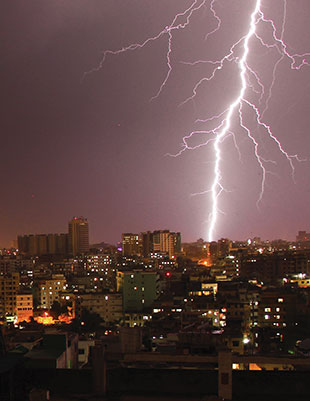






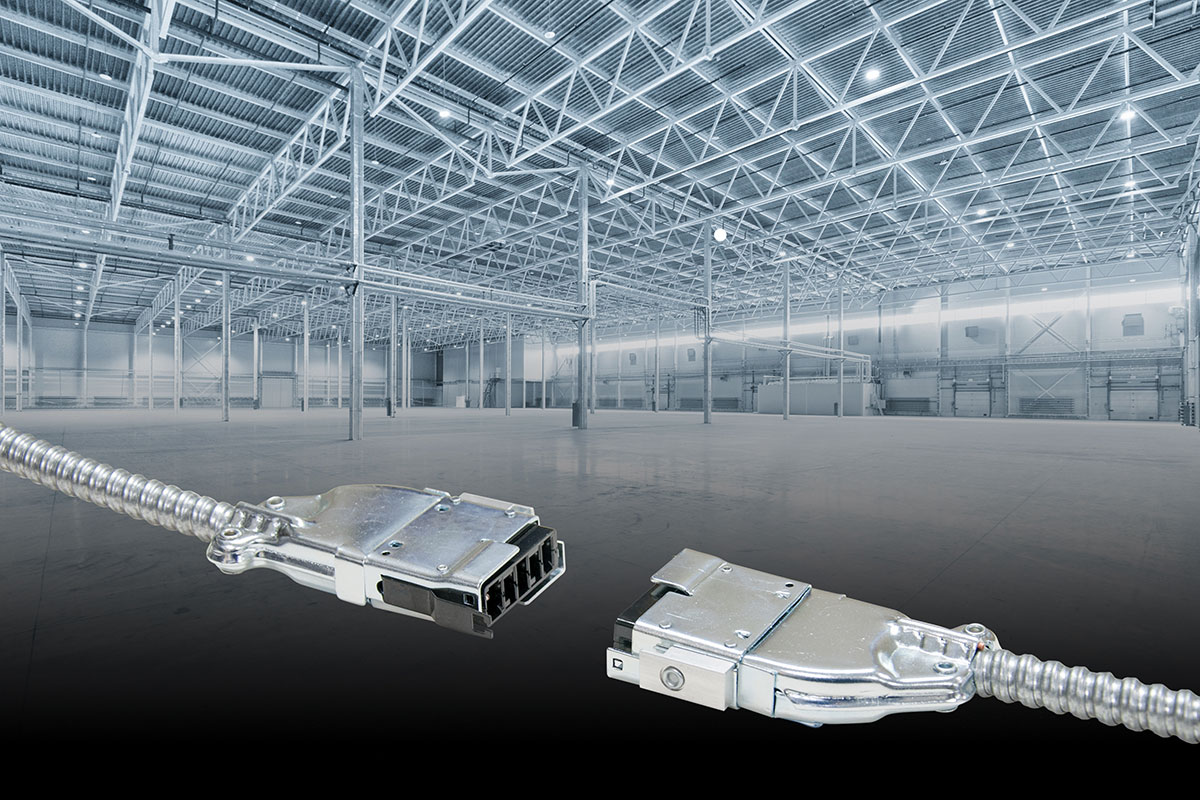

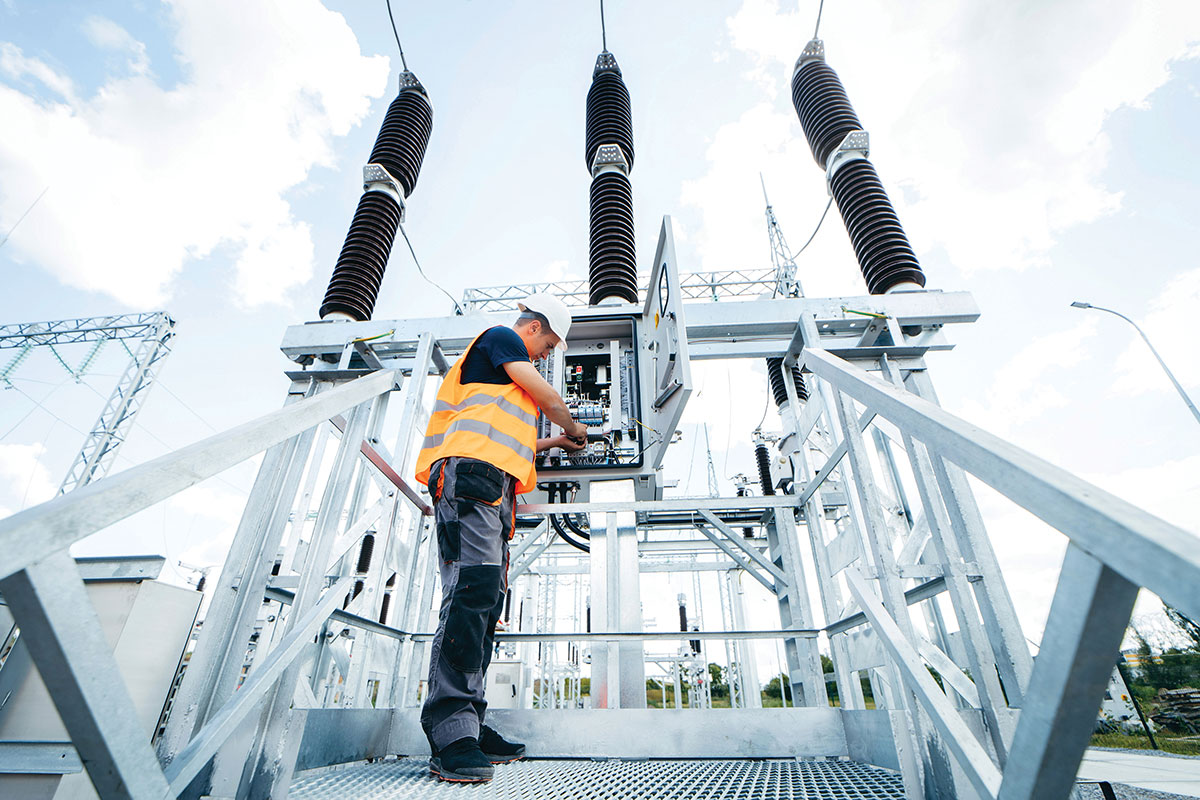
Find Us on Socials